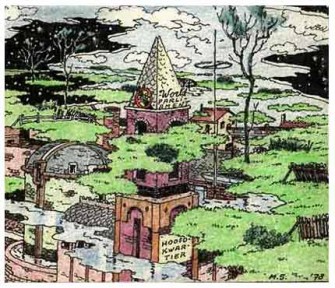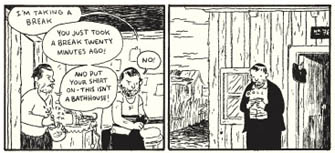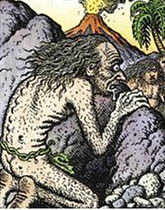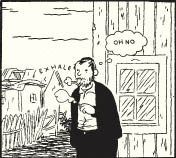 Home > CR Interviews
Home > CR Interviews A Short Interview With Sammy Harkham
posted September 9, 2006
A Short Interview With Sammy Harkham
posted September 9, 2006


I met Sammy Harkham at his table in San Diego several years ago now -- I think I was still working for Fantagraphics, which means Sammy was probably barely out of his teens. He was then, as now, unleashing his anthology
Kramers Ergot on an unsuspecting and even unforgiving world. A few issues ago,
Kramers outgrew its identity as an effective showcase for the Los Angeles-based cartoonist and a few like-minded artistic travelers to being the still-young cartoonist's statement on what he finds worthwhile in the art form. The result is the first significant art-comics anthology of the new century, a worthy successor to
Arcade,
RAW and
Weirdo, snapshots of an art form that more often than not lugs its most traditional values with it all the way out to its cutting edge.
Kramers is one of a handful of comics with which I feel you
must grapple in order to understand this era of the medium's history. This latest issue, with bold, confident work from artists like Victor Cayro, Ron Rege, Jr., and Tom Gauld, may be the best yet.
*****
TOM SPURGEON: Sammy, you told me that you think this might be the last Kramers Ergot
for a while. What did you mean by that?
SAMMY HARKHAM: Well, for one thing, the plans I have for the next two issues -- if they happen -- would make putting together an issue longer than usual. They are sort of different than previous issues. The other thing, the continual thing, is that it always seems like there's not enough new exciting work that makes me get excited about making an issue.
SPURGEON: Tell me about the nuts and bolts of putting this issue together. Do you start with a list? Does everyone get invited back? Is everyone you asked in this volume?
HARKHAM: With this issue I started getting excited about the possibilities when I visited
Tom Gauld in England in July of 2004.
Kramers 5 was about to go the printer and I was pretty exhausted with it, burnt out. But visiting Tom's studio made me want to publish a long story by him. At that point I don't know if he had been approached by North American publishers, but there didn't seem like anything was on the horizon, and as a reader I wanted to see something in print. So Tom was the first thing. Then
Alvin [Buenaventura] showed me
Tagawa. Then I read through a stack of
Matthew Thurber comics.
Those three things made me feel like a sixth issue could be good, but I was unsure and didn't want to retread previous issues. Then I remembered
Shary Boyle, who was someone I have liked for a long time but never approached. She agreed. Things started to take some abstract form of what the issue could be, aesthetically, just thinking of those cartoonists together. And then Tagawa makes me think of
Paper Rad and
Souther Salazar, and connections start forming. You think of who fits well in all this and you make a list. And you sit on it and stare at it and think on it. I always just think in terms of what I want to see, not who I can get.
I contacted the people on my list, then I added people as I went along.
SPURGEON: Did anyone bow out or refuse?
 HARKHAM:
HARKHAM: Since you ask,
Debbie Drechsler refused, and three or four people cancelled on me. On the flipside, I asked
Dan Zettwoch super late, basically at the last minute, and he came through and delivered an incredible story two weeks later.
SPURGEON: I'd love to hear your impressions of a few of the artists whose includions I thought were particularly fascinating -- what you think the value of the material is, and what you might want someone to notice about it, how you might present it to someone... just your thoughts on why you're excited to include it.
HARKHAM: Let me preface by saying I am not particularly good at discussing art...
SPURGEON: First up: Victor Cayro.
HARKHAM: He is someone who is easy to dismiss in many ways -- it's overtly vulgar, the drawing, while virtuosic, verges on overkill, and it's filled with racist and sexist imagery that's not presented in any way in which it's clear to the author that he is being racist or sexist. but then you read it and it becomes inherently clear that Cayro is laying it all out. I think it's as emotionly honest as anything in comics. And the more you read it, the more the drawings, which seemed to exist as "style," work as a perfect physical manifestation of the character's state of mind. All the macho Robocop/John McClain posturing reveals itself to exist as a moral sheild for someone to keep on living. It's scary and mindblowing how far he goes with it. Anytime I read his stories, it is always clear that it is thinly-veiled autobio. Anyone who just disregards it because they think it's all effect or phony is not really giving it a chance, I think. It's pretty heartbreaking work.
I initially didn't know if he would be a good fit in the book, aethetically. But I realized that if
Kramers is the sort of book where this doesn't fit, then
Kramers is fucked.
SPURGEON: Shary Boyle?
HARKHAM: It's absolutely beautiful is the first thing that comes to mind. I like the mystery of her art. It's not narrative, but it is. She composes her images so perfectly they work narratively. Her art makes me uncomfortable and evokes many conflicting emotions. I love how her drawings find this perfect balance between just the right amount of information and being decorative, like the best comics. Boyle's work hits at that point between sexuality, spirituality and human clumsiness/mischief.
SPURGEON: Elvis Studio.
HARKHAM: Their art feels impossible. There's such a sheer amount of labor/craft in the work that is quite striking all its own. They have a great ability to seem to "quote" everything they come in contact with and present something new. I think its amazing how two people can find each other and create such a cohesive point of view. Individually, I think
Helge Reumann is just a great cartoonist period, and
Xavier Robel is master at using space and design narratively.
 SPURGEON: Last one: Suiho Tagawa.
SPURGEON: Last one: Suiho Tagawa.
HARKHAM: He's like a dream come true in so many ways. First of all, he is an incredible storyteller. His strips just move so gracefully. On top of that, his art has not aged one bit in my eyes -- except for the fascism and racism! In many ways his strip is the exact thing I want to put in
Kramers: underseen, well-plotted, wonderfully drawn. I look at his work and feel like he could share a studio with Paper Rad and Souther Salazar.
SPURGEON: Now, are you at the point you're getting blind submissions? What are they like?
HARKHAM: I receive a lot of stuff in the mail and through e-mail. Not really submissions, mostly samples of work. A lot of it is quite interesting and/or good. I get a lot of non-comics stuff and "abstract" stuff.
SPURGEON: Have you ever used one?
HARKHAM: I have not published anything yet from a blind submission. People don't seem to realize that if it's comics, my usual preference is for narratives, and if it's not comics, I like stuff to be in the realm of the comics language. Theres a lot of artists I love but won't put in
Kramers because they won't fit in a comic book like
Kramers.
SPURGEON: I think most people think of Kramers Ergot
as being split being narrative comics and more decorative, fanciful, out-there comics. Do you look for work with a certain balance in mind? How do you view the differences between the kinds of works you find in Kramers
?
HARKHAM: I don't think in terms of any sort of balance between narrative or "decorative" comics. If tomorrow there were 30 people without publishers doing good strong narrative comics in the vein of
[Adrian] Tomine,
Gabrielle Bell and
[Kevin] Huizenga, that would be an issue of
Kramers. I publish stuff I think is exciting and good. It doesn't matter if its
[Jerry] Moriarty's paintings or Matthew Thurber or Tom Gauld. What's important is that the whole is more than the sum of its parts. I see connections between cartoonists. And a cartoonist readers are familiar with can take on a whole new light positioned amongst certain others. I spend a long time balancing stuff out and trying to make everything fit cohesively. I dont know what makes a strip feel appropriate; its pretty intuitive.
SPURGEON: Now that you have it back in your hands, how exactly do you feel this volume is different than the previous few?
HARKHAM: I am happy that issue six is not a retread of previous issues -- not the just the same faces reappearing again and again. I happy we got to publish Tagawa and
Smeets. And I like that Victor Cayro's strip fits well with the rest of the book. I was nervous it wouldn't, that it was too different. But I think its a good addition.
SPURGEON Can you point to a through-line that connects the last few volumes?
HARKHAM: I guess the "through-line" would be that everybody in the books makes work that feels honest, that it comes from a real place and is good. Honestly, that's the only way I can think the same book can contain strips from
[Mat] Brinkman, Huizenga, Paper Rad, Gabrielle Bell, Tagawa, etc, can feel cohesive. Because each one of these artists is an example of what we all like in art -- honesty, vision, craft.
 SPURGEON: Did Chris Ware bring Smeets to your attention?
SPURGEON: Did Chris Ware bring Smeets to your attention?
HARKHAM: Ware brought Smeets to my attention indirectly through
Comic Art Magazine. Then I read/saw Patrick Rosenkranz's piece
on Dutch comics in a later issue. I was pretty blown away by it. I wrote to Ware asking for any info he might've had on rights and available work. He had scans available and contact for Smeets' estate to make the inclusion in the book possible.
SPURGEON: How did you get Ware and Paul Karasik to write the introductions for Smeets and Tagawa?
HARKHAM: I can't remember whose idea was it to have Ware write an intro. I would guess Alvin. I had no problem publishing it without the intro, but once suggested, I thought that, as a reader, it could add more appreciation to the work. Same reason for the Tagawa intro. Karasik is a smart guy and was enthusiastic to write something.
SPURGEON: Why do introductions on those artists and not, say, Souther or Dan?
HARKHAM: I guess I don't feel like introductions are so necessary in appreciating the work but in the case of Smeets and Tagawa felt like a bit of background info could add a lot. You could argue that an intro to any artist can create a better appreciation but one thing I try to do with
Kramers is to make it feel immediate and less like art book which has a tendency to distance the reader from the work somewhat. I felt like that context for those artists was appropriate.
The short answer is I don't know.
SPURGEON: A lot of the works in this new issue seem connected by how much they break with more traditionally cinematic and staged comics -- many have these giant, sweeping tableaux, or these very intimate close-ups. Do you think Kramers has had some value in drawing attention to how these artists break with these almost ingrained traditions of comics? Or is that overrated?
HARKHAM: I don't know if I understand your question. I'm unsure if you mean concerning the artists themselves or if you mean in more broad terms. It seems like you're talking about the artists themselves. If so, I would say its not their breaking with cartooning norms or whatever that makes them great. And besides, I would say they are all pretty traditional when you get right down to it.
This makes me think of
Jimmy Corrigan: Smartest Kid on Earth. When that first came out, a lot of what was initially striking was
how Ware told his story. It felt groundbreaking. Now, many years later, those innovations are not what makes it striking, but the more traditional aspects of it. at least to me. That's not to say
Kramers is important like
Jimmy Corrigan is, but just to point out that what makes a work great is not its formal properties. Even something as formal as
[Richard] Maguire's "Here" is great because of how he uses formal innovation to get to the emotional heart of the ideas.
Oh Lord, please kill me. Sorry, Tom!
 SPURGEON: [laughs] Let me ask how you approached your own work this time around. "Lubavitch, Ukraine 1876" is as visually challenging as anything I've seen you do. You have this really tight grid that feels boxed in and constrained, and utilize this slow progression of time, even the dropping out of backgrounds when it suits you. What effect were you trying to achieve through this very controlled narrative?
SPURGEON: [laughs] Let me ask how you approached your own work this time around. "Lubavitch, Ukraine 1876" is as visually challenging as anything I've seen you do. You have this really tight grid that feels boxed in and constrained, and utilize this slow progression of time, even the dropping out of backgrounds when it suits you. What effect were you trying to achieve through this very controlled narrative?
HARKHAM: I am getting more and more interested in the layering of moments on top of moments and how all things, piled up, can take on a particular resonance taken as a whole. Very much like looking back at a period of your life. This is what I love so much about Frank King's work. You start reading
Gasoline Alley and it doesn't hit at first what's going on. But as it continues you really get the sense of time passing, of the ebb and flow of daily life in its details, things connecting, other things not. I want my stories to feel like memories in a certain way. The uniform panel size is a way of giving equal "emotional" space to each moment. That in turn, I think, makes an emotional point much richer.
The great cartoonist
Jason has said, "You go halfway and the reader will go the other half." I really agree with this. The cartoonist is not spelling out which panels are the punchline or center of a scene. The reader engages it more. It's not appropriate for all strips, but for "Lubavitch" it seemed like the right way. Also, having many panels on page, jamming it with information, helps with this idea.

The general conceit of the strip was a way for me to talk about my life without distancing the reader. Setting an autobio strip a hundred and fifty years ago has an innate humor to it -- my initial inspiration was crumb's "Cave Wimp" strip -- and gave me an "in" to talk about Judaism/spirituality/God concepts without being weird and preachy. But by giving the main character my name, it has a way of stopping the strip from becoming about how people
used to live, but how they still live. It was a struggle to create a balance between being humorous and still talking about why anyone lives an orthodox jewish life, without being preachy or aggressive with my opinions.
I don't know if the strip was successful at anything: being funny or truthful or entertaining. It was only once Alvin read it and convinced me it should be published that I thought it could have any interest to people and put it in
Kramers.
SPURGEON: You've been doing the more ambitious Kramers
issues for a while now. What about the way people have reacted to it has been most satisfying for you? Have you ever been surprised by what someone had told you about reading your anthology? If this ends up being the last one, are you happy with the way they've turned out?
HARKHAM: Firstly, I dont think an editor is ever happy, and can always see things that can be improved. Secondly, its not the last one.
I am glad when I meet someone and they say they discovered someone's work in
Kramers. That's the point, isn't it? I love comics, and like anyone who loves comics I get disappointed with comics -- that good work goes unnoticed, that stuff that should be reprinted isn't, that good work is badly printed or designed, etc etc.
Kramers Ergot is for me a way to keep being excited with the medium.

You forget how slim the pickings are in the comic shop every week when you can barely keep your anthology at 340 pages. You want to contribute something good to the medium. But amazing things are happening. Since
Kramers Ergot 4,
Drawn and Quarterly and Fantagraphics have started publishing a lot more, for a lack of a better word, "new" cartoonists, and new publishers like
Picturebox,
Buenaventura Press and
Typocrat have started popping up publishing great stuff. The chances of stuff falling through the cracks seems to have diminished somewhat. It's a good time in comics, I think.
As far as things that have surprised me since
Kramers 4, I would say I was pretty disappointed by some of the antagonism directed to the book within comics circles. People saying it's all fashion/druggy/lacks substance/doesn't have enough comics/blah blah. Especially when similar art anthologies like
Blab! run non-comics work and seem to go unscathed.
Something about the book bothers some readers for some reason. it doesn't make sense, considering I have published all sorts of narrative cartoonists like Gabrielle Bell,
Jeff Brown, Kevin Huizenga and Chris Ware. There is no agenda. I am not interested in the fine art world or the wider book publishing world.
Kramers Ergot has always been, in my mind, a comic book. Something that would be sold in comic shops. But after #4, I realized that comic fans, for the most part, are not interested and bring baggage to the book, reading into the work stuff that is just not there. I started to question if going into comics was a bad decision made too late. Like I was in the wrong industry. This probably had a bit to do with being 24 and sort of reevaluating everything anyway. It seems many people in comics don't feel a part of comics and it's probably a good thing.
*****
Kramers Ergot Site
Buenaventura Press' Kramers Ergot Page
*****
all art from KE 6 except the Smeets picture and Cave Wimp
*****


